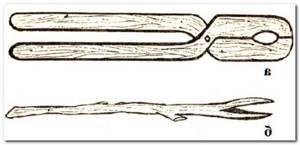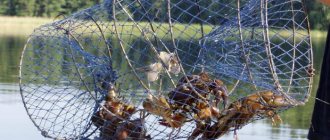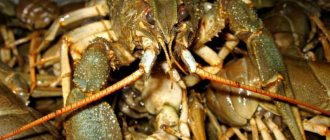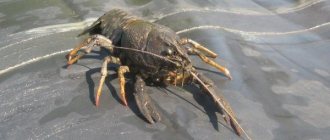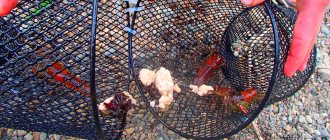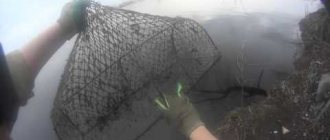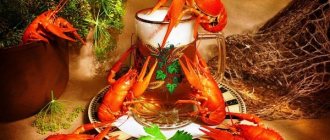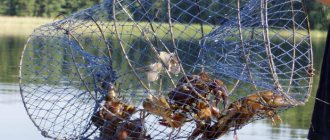It is best to catch them during this period with crayfish. This is a fairly effective tackle that allows you to catch crayfish both in winter and summer. Moreover, the fishing technology is absolutely identical with not much difference. If you have had experience catching crayfish in the summer, you will definitely succeed in the winter.
In winter, crayfish move to deeper places where there is a more suitable temperature regime. But the cancer does not sit in one place and from time to time visits the shallows. Although their activity decreases, it is very slight, so crayfish can be caught constantly. The main thing is to do it correctly.
Catching crayfish in winter - what you need to know?
The technique of winter fishing for crayfish is practically no different from similar fishing in the warm season. The only thing that may be difficult is pulling the prey out from under the ice.
Freshwater crayfish settle only in clean water bodies. A characteristic feature of this animal is the presence of a strong chitinous coating (shell). This exoskeleton protects the crayfish from predators and makes it virtually invulnerable. These aquatic inhabitants prefer to live on a rocky bottom, where it is easier for them to camouflage themselves.
Note: Such winter fishing also has a significant advantage: in the cold season, the probability of catching large specimens, the meat of which has a more pronounced taste, is much higher.
The best period for catching crayfish is considered to be the end of autumn or the beginning of winter. During this period, underwater inhabitants have already gained enough weight in anticipation of the cold weather. The main feature of winter fishing is that you will have to cut wider holes than for catching fish. This is necessary so that the crayfish trap or other gear can be lowered into the water without any problems.
Figure 1. You can catch crayfish not only in the warm season, but also in winter
It should also be taken into account that crayfish prefer to settle in clean reservoirs with a rocky bottom (Figure 1). And, if in the warm season they can be found already at a depth of 2-3 meters, then with the onset of cold weather the animals move to depth and lie down in muddy pits. Therefore, it is important to choose a place for fishing in advance, and also prepare a fragrant bait that will lure crayfish from their holes.
Twist
This simple ancient method is still used in certain regions. The main thing is that there is a lot of underwater vegetation in the fishing area, otherwise you won’t catch anything. Twisting of crayfish is carried out in the following way:
- a long piece of strong metal wire with a bend at the lower end and a convenient eyelet at the upper is lowered into the hole;
- make up to ten turns, trying to wind as much grass as possible onto the hook;
- They lift the algae up and, having spread them on the ice, select crayfish.
To some, such fishing may seem quite simple, but in practice it is a terribly labor-intensive process, the result of which depends on the patience of the hunter and his physical capabilities. There are also advantages: twisting does not involve any costs, there is no need to wait for the prey to crawl in on its own.
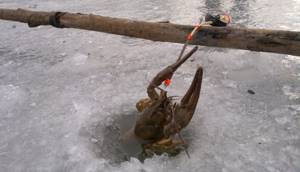
Is it possible to catch crayfish in winter?
In the cold season, crayfish, although they change their habits somewhat, still do not hibernate, so you can catch them in winter. And given the fact that with the onset of cold weather you can catch larger individuals than in the summer, this fishery has additional value.
To ensure successful fishing, consider the following features:
- Crayfish are very demanding of their habitat, so never settle in a pond that is polluted or overgrown with vegetation.
- These aquatic creatures are most often found in rivers, but in some cases they can be found in lakes and ponds that are fed by underground springs.
- With the arrival of cold weather, crayfish move from shallow water to depth and dig holes in the bottom layer, because it is here that the water temperature is much higher than at the surface.
- When choosing a body of water for fishing, be sure to take into account the features of its bottom. Crayfish will never settle on sandy or muddy surfaces, as they simply will not be able to build themselves a reliable shelter. The best habitat is considered to be reservoirs with a rocky or muddy bottom. It’s even better if there is a steep rocky shore nearby, and there are old tires, tin cans or other similar containers in the water, because mustachioed animals often set up their shelters in them.

During the day, crayfish prefer to hide in holes and go out to feed in the dark, so it is better to go fishing at night. In addition, during the cold season, these underwater inhabitants rarely swim into shallow water in search of food, preferring to stay in medium depths (Figure 2).
Diet
The diet of adult arthropods is extremely diverse; we can say that they eat literally everything. Young individuals rarely get animal food, so they are forced to be content with plant debris, while the menu of large crayfish consists of many different “products”. This:
- plankton;
- shells;
- benthic invertebrates;
- larvae of various insects;
- water fleas;
- sleeping fish;
- molting young (unfortunately, crayfish are cannibals).
It is worth noting that these underwater inhabitants bring great benefits by eating carrion and thereby preventing water pollution. Carrion is a delicacy for them, so hunters most often use spoiled meat as bait.
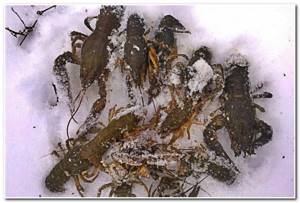
Choosing the optimal time
Catching crayfish throughout the year is determined by the habits of these aquatic inhabitants. Accordingly, in order to accurately determine the time and place suitable for fishing, it is necessary to study the preferences of mustachioed inhabitants of reservoirs (Figure 3).
It is advisable to carry out fishing taking into account the following features:
- Crayfish prefer to accumulate near steep river or pond banks, since it is much easier for them to obtain food in such areas than on a flat bottom.
- Choose rivers and ponds with weak currents, as crayfish do not live in places with strong water currents.
- Try to go fishing in rivers and lakes with clay or rocky bottoms. Crayfish simply cannot build burrows on sandy or muddy soil.
- Try to go fishing at night, as the mustachioed underwater inhabitants go hunting precisely in the dark.

. In addition, it is recommended to fish different layers of the water column, since crustaceans can get food both in shallow water and at great or medium depths. To do this, it is better to install several crayfish traps at different depths at once, so that you have the opportunity to determine which part of the reservoir gives the largest catch.
Proposal for cooperation - crayfish wholesale in Moscow
{"items":["6017ca55db48d10017884d60","5ff9d9fec726e90017c75a7d","5ff8468ddb825200171890bf","5faf88dd3546e1001723fa1f","5fad01dceccfba00170fd8dd", "5fab85c8e75d7700179b2590","5f329cc90f66cc0017f35b09","5f329a55ea4c690017fa7cb0","5f3255c3ae4796001750442f","5f28341da3c2210017f216b9"]" styles" :{"galleryType":"Columns","groupSize":1,"showArrows":true,"cubeImages":true,"cubeType":"max","cubeRatio":1.7777777777777777,"isVertical":true,"gallerySize ":30,"collageAmount":0,"collageDensity":0,"groupTypes":"1","oneRow":false,"imageMargin":22,"galleryMargin":0,"scatter":0,"rotatingScatter ":"","chooseBestGroup":true,"smartCrop":false,"hasThumbnails":false,"enableScroll":true,"isGrid":true,"isSlider":false,"isColumns":false,"isSlideshow" :false,"cropOnlyFill":false,"fixedColumns":0,"enableInfiniteScroll":true,"isRTL":false,"minItemSize":50,"rotatingGroupTypes":"","rotatingCropRatios":"","columnWidths" :"","gallerySliderImageRatio":1.7777777777777777,"numberOfImagesPerRow":3,"numberOfImagesPerCol":1,"groupsPerStrip":0,"borderRadius":0,"boxShadow":0,"gridStyle":0,"mobilePanorama": false,"placeGroupsLtr":true,"viewMode":"preview","thumbnailSpacings":4,"galleryThumbnailsAlignment":"bottom","isMasonry":false,"isAutoSlideshow":false,"slideshowLoop":false,"autoSlideshowInterval ":4,"bottomInfoHeight":0,"titlePlacement":["SHOW_ON["SHOW_ON_THE_RIGHT","SHOW_BELOW"]TextAlign":"center","scrollSnap":false,"itemClick":"nothing","fullscreen" :true,"videoPlay":"hover","scrollAnimation":"NO_EFFECT","slideAnimation":"SCROLL","scrollDirection":0,"scrollDuration":400,"overlayAnimation":"FADE_IN","arrowsPosition" :0,"arrowsSize":23,"watermarkOpacity":40,"watermarkSize":40,"useWatermark":true,"watermarkDock":{"top":"auto","left":"auto","right ":0,"bottom":0,"transform":"translate3d(0,0,0)"},"loadMoreAmount":"all","defaultShowInfoExpand":1,"allowLinkExpand":true,"expandInfoPosition": 0,"allowFullscreenExpand":true,"fullscreenLoop":false,"galleryAlignExpand":"left","addToCartBorderWidth":1,"addToCartButtonText":"","slideshowInfoSize":200,"playButtonForAutoSlideShow":false,"allowSlideshowCounter" :false,"hoveringBehaviour":"NEVER_SHOW","thumbnailSize":120,"magicLayoutSeed":1,"imageHoverAnimation":"NO_EFFECT","imagePlacementAnimation":"NO_EFFECT","calculateTextBoxWidthMode":"PERCENT","textBoxHeight" :60,"textBoxWidth":200,"textBoxWidthPercent":75,"textImageSpace":10,"textBoxBorderRadius":0,"textBoxBorderWidth":0,"loadMoreButtonText":"","loadMoreButtonBorderWidth":1,"loadMoreButtonBorderRadius": 0,"imageInfoType":"ATTACHED_BACKGROUND","itemBorderWidth":0,"itemBorderRadius":0,"itemEnableShadow":false,"itemShadowBlur":20,"itemShadowDirection":135,"itemShadowSize":10,"imageLoadingMode": "BLUR","expandAnimation":"NO_EFFECT","imageQuality":90,"usmToggle":false,"usm_a":0,"usm_r":0,"usm_t":0,"videoSound":false,"videoSpeed ":"1","videoLoop":true,"jsonStyleParams":"","gallerySizeType":"px","gallerySizePx":1000,"allowTitle":true,"allowContextMenu":true,"textsHorizontalPadding":- 30,"itemBorderColor":{"themeName":"color_12","value":"rgba(199,199,199,0)"},"showVideoPlayButton":true,"galleryLayout":2,"calculateTextBoxHeightMode":"MANUAL"" targetItemSize":1000,"selectedLayout":"2|bottom|1|max|true|0|true","layoutsVersion":2,"selectedLayoutV2":2,"isSlideshowFont":true,"externalInfoHeight":60," externalInfoWidth":0.75},"container":{"width":220,"galleryWidth":242,"galleryHeight":0,"scrollBase":0,"height":NULL}}
Archive
Search by tags
How to catch crayfish in winter
At first glance, it may seem that catching crayfish in winter is difficult. In fact, this is a fairly simple task, and the only difficulty is drilling a hole wide enough to place the gear in it.
There are quite a lot of ways to get a trophy, but we will look at the most popular and effective of them.
Under the ice
In reservoirs with abundant vegetation, the so-called crayfish spinning is often practiced. This is a slightly outdated method, but some fishermen still use it due to its simplicity and effectiveness (Figure 4).
Note: The only condition is to go fishing in a truly overgrown body of water. On clean rivers or ponds, this method will bring absolutely no results.
Spinning crayfish under ice is carried out as follows:
- Take a thick wire, the length of which should approximately correspond to the depth of the reservoir. A hook is made at one end of the wire, and a bend is made at the other end, which will help rotate the tackle.
- A small hole is cut in the ice and the tackle is lowered into it with the hook down.
- Next, you need to twist the wire around its axis several dozen times. This is necessary so that a sufficient amount of algae is wound around the metal.
- After this, the wire is simply pulled out of the water and crayfish that are entangled in aquatic vegetation are selected.

At first glance, it may seem that this fishing method cannot be effective. In fact, this is a fairly simple method, and with some skill it can really bring you a rich catch with minimal labor. However, to obtain abundant prey, you need to choose the right body of water and be sure that crayfish live in it. In fact, the volume of your catch will depend on the number of holes drilled and the time you are willing to spend manipulating the wire. Among the advantages is the speed: you just need to twist the wire in the hole, and you don’t have to wait for the crab to react to the bait and crawl into the trap.
Hands
In the summer, many people practice catching crayfish with their hands, simply diving into the water and pulling the prey out of the holes. But this method is quite risky, because the hand can easily get stuck in a hole, and the fisherman’s life will be in danger. In winter, this method is completely impossible, because diving and swimming in cold water is not a pleasant activity (Figure 5).
However, if you go fishing to a reservoir where the water level is regulated by sluices, you will still be able to catch a sufficient number of crayfish by hand. This way you won't have to put your hands in cold water, but the catch will be quite large.
Note: You can catch crayfish in this way only before the freeze-up, when the floodgates are opened and the water is drained from the reservoir.

When the water begins to recede quickly, crayfish, due to their slowness, simply do not have time to keep up with it, although they leave their burrows. Lovers of crayfish meat can only walk along the bottom of the drained reservoir and collect the prey.
On the fishing rod
You can also catch crayfish using a regular float rod, and this type of fishing is much more interesting than other methods, because it involves active action and constant movement (Figure 6).
Gateways
Interestingly, you can even catch tasty representatives of the ichthyofauna with your hands, without lowering your limbs into icy water. This is possible on rivers where the water level is regulated using special hydraulic structures - sluices.
When the floodgates are opened before the freeze-up, the water quickly leaves, and the slow-moving crayfish, lingering in their burrows, have to catch up with it on land. It is on the day of water release that lovers of crayfish meat and beer appear on such a reservoir and wander along the shore, collecting prey. But this method cannot even be called poaching; it is rather barbaric. You should not take it into service, otherwise next year there will be nothing to catch. It is better to use such timeless and quite effective tackle as a crayfish catcher, which was invented by our grandfathers and great-grandfathers.
For winter catching crayfish, the following statement is relevant: informed means armed.
That is, you can’t just come to a pond, drill a hole in the first place you come across and immediately catch a mountain of arthropods. At a minimum, you need to know for sure that they live here. In addition, it is necessary to have at least basic knowledge about the characteristics of their behavior in winter, food preferences, periods of activity, and so on. Let's start with this.
Catching crayfish in winter using a crayfish trap
Rakolovka is the most popular way of catching baleen underwater inhabitants, because such a trap allows you to get rich prey (Figure 7).
According to their design, the shells are either open or closed. The first type is much simpler, and you can make such a trap with your own hands from scrap materials. As a rule, wood or metal mesh is used for this purpose. As a base, take a metal or wooden circle, onto which a mesh is put so that the finished structure looks like a colander. A cord is tied to one side of the trap so that it is convenient to lower the crayfish into the water and remove it from it.

Figure 7. Rakolovka - the simplest and most effective method of obtaining a catch
Closed-type shells are considered more effective, although their design is a little more complicated. The cancer simply cannot get out of such a trap, so even if you threw several dozen similar structures and left them for a while, you don’t have to be afraid that you will be left without a catch. The bait is placed in the center of such a trap, the structure is lowered to the bottom, and the cable is tied to a tree or snag. You can raise such a shell to collect prey once an hour. But, if you use open-type traps, you need to check them more often so that well-fed crayfish do not escape.
In winter crayfish fishing, the same baits are usually used as for summer fishing. Pork liver, beef udder and regular garlic are considered the most effective. In order for the animal to smell the food, it must be properly prepared. For example, meat is simply cut into large pieces and placed inside a shell, and peeled garlic cloves are divided in half and wrapped in gauze. If the products listed above are not on hand, you can use any other meat or fish.
The technique of catching crayfish using a crayfish is shown in more detail in the video.
Fishing with a split stick
This method is effective when catching crayfish at shallow depths, such as under a wall of reeds parallel to the shoreline. The depth should be such that arthropods can be seen at the bottom. In the selected promising area, you need to drill a large number of holes at intervals of no more than a meter. Next, you should prepare the “tackle” - split one end of the stick and insert a match into the split. Now all that remains is to carefully examine the bottom in each hole. If a crayfish appears, it is enough to hit its claw with a cleft, the match will break and the limb will be clamped in the stick. I couldn't think of anything simpler.
